Recent Progress in Biomass-Derived Carbon Materials for Li-Ion and Na-Ion Batteries—A Review
Abstract
:1. Introduction
2. Li-Ion Batteries (LIBs)
3. Sodium-Ion Batteries (NIBs)
4. Biomass-Derived Carbon Materials-Syntheses and Properties for LIBs and NIBs
5. Biomass Carbon Anode for LIBs
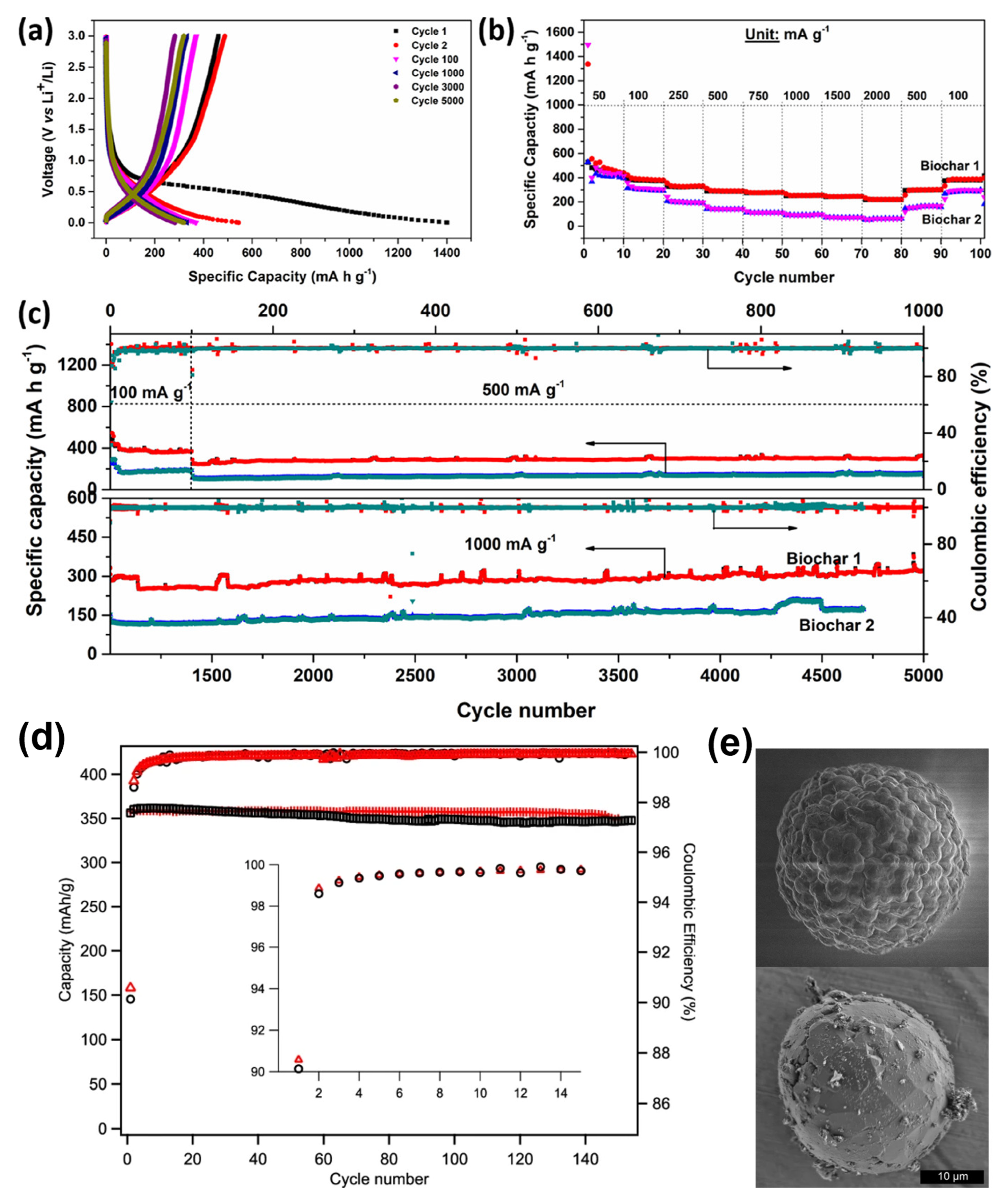
| Biomass Source | Synthesis Method | Morphology | Specific Surface Area (SSA, m2/g) | Initial Capacity (Discharge/CHARGE) (mA h g−1) | Capacity Retention (mA h g−1)/(Cycles) | Rate Test (mA g−1), (Cycle)/Capacity (mA h g−1) | Ref. |
|---|---|---|---|---|---|---|---|
| Sisal fiber | Hydrothermal activation method | Honeycomb (disordered carbon layers and micropores) | 616.4 | 646 | ~550 (30) | - | [74] |
| Banana peel | high-temperature KOH activation method | High dense banana peel pseudo graphite | 217 | ~2150/1075 | 800 (300) | 10,000 (10) ~100 | [80] |
| Bagasse | Hydrothermal activation method | N, P co-doped bagasse-based sheet-like mesoporous carbon | 1307.21–2118.59 | 2347.56/1186.59 | 816.36 (50) | 2000 (200) 592.38 | [81] |
| Portobello mushroom | binder-free, and current collector-free Li-ion battery anodes | Carbon nanoribbon as free-standing | 19.6 | 771.3/280 | ~260 (700) | - | [82] |
| Mustard seed waste | Hydrothermal method | high porous spherical carbon nanostructures in-situ doped of heteroatoms (N, S) | 618 | ~822/617 | ~714 (550) | 500 (10) 280 | [83] |
| Tamarind plant Seeds | High temperature KOH activation method | porous carbon | 103.51 | ~1037/414 | ~370 (100) | - | [84] |
| Rice Straws | high temperature KOH activation method | High porous carbon | 3315 | 2041/986 | - | 744 (5) 257 | [85] |
| Cherry Pit | KOH and H3PO4 activation, | Disordered carbons | 1662 | ~1300/300 | 200 (200) | 1860 (5) 70 | [75] |
| Jute Fiber | High temperature carbonization in open atmosphere | Micro-mesoporous carbon | 1028.614 | 1173.3/534.1 | 427.2 (100) | 1860 (10) 171.6 | [86] |
| Coffee waste grounds | mechanochemical dry milling of spent coffee grounds followed by further carbonization at 800 °C | Non-porous carbonaceous materials | <10 | 764/~380 | 285 ± 5 (100) | 1000 (10) 150 | [87] |
| Spruce wood | pyrolysis and ball milling method | Spruce hard carbon | 61 | ~400/250 | 300 (400) | 1488 (10) ~110 | [88] |
| Gold beard grass pollen | pyrolysis and KOH activation method | Mesoporous carbon powder from bee-collected pollens | 1107.447 | 788.99 | 297.283 (200) @ 2000 | 5000 (-) 334.10 | [89] |
6. Biomass-Derived Carbon Anode for NIBs
7. Conclusions and Outlook
Author Contributions
Funding
Institutional Review Board Statement
Informed Consent Statement
Data Availability Statement
Acknowledgments
Conflicts of Interest
References
- Abdelbaky, M.; Peeters, J.R.; Dewulf, W. On the Influence of Second Use, Future Battery Technologies, and Battery Lifetime on the Maximum Recycled Content of Future Electric Vehicle Batteries in Europe. Waste Manag. 2021, 125, 1–9. [Google Scholar] [CrossRef] [PubMed]
- Ding, Y.; Cano, Z.P.; Yu, A.; Lu, J.; Chen, Z. Automotive Li-Ion Batteries: Current Status and Future Perspectives. Electrochem. Energy Rev. 2019, 2, 1–28. [Google Scholar] [CrossRef]
- Cavers, H.; Molaiyan, P.; Abdollahifar, M.; Lassi, U.; Kwade, A. Perspectives on Improving the Safety and Sustainability of High Voltage Lithium-Ion Batteries Through the Electrolyte and Separator Region. Adv. Energy Mater. 2022, 12, 2200147. [Google Scholar] [CrossRef]
- Kim, T.; Song, W.; Son, D.-Y.; Ono, L.K.; Qi, Y. Lithium-Ion Batteries: Outlook on Present, Future, and Hybridized Technologies. J. Mater. Chem. A 2019, 7, 2942–2964. [Google Scholar] [CrossRef]
- Tarascon, J.-M. Is Lithium the New Gold? Nat. Chem. 2010, 2, 510. [Google Scholar] [CrossRef]
- Zhao, L.; Zhang, T.; Li, W.; Li, T.; Zhang, L.; Zhang, X.; Wang, Z. Engineering of Sodium-Ion Batteries: Opportunities and Challenges. Engineering 2022. [Google Scholar] [CrossRef]
- Mohan, I.; Raj, A.; Shubham, K.; Lata, D.B.; Mandal, S.; Kumar, S. Potential of Potassium and Sodium-Ion Batteries as the Future of Energy Storage: Recent Progress in Anodic Materials. J. Energy Storage 2022, 55, 105625. [Google Scholar] [CrossRef]
- Tarascon, J.-M. Na-Ion versus Li-Ion Batteries: Complementarity Rather than Competitiveness. Joule 2020, 4, 1616–1620. [Google Scholar] [CrossRef]
- Madian, M.; Eychmüller, A.; Giebeler, L. Current Advances in TiO2-Based Nanostructure Electrodes for High Performance Lithium Ion Batteries. Batteries 2018, 4, 7. [Google Scholar] [CrossRef]
- Hu, H.-Y.; Xiao, Y.; Ling, W.; Wu, Y.-B.; Wang, P.; Tan, S.-J.; Xu, Y.-S.; Guo, Y.-J.; Chen, W.-P.; Tang, R.-R.; et al. A Stable Biomass-Derived Hard Carbon Anode for High-Performance Sodium-Ion Full Battery. Energy Technol. 2021, 9, 2000730. [Google Scholar] [CrossRef]
- Zhang, H.; Yang, Y.; Ren, D.; Wang, L.; He, X. Graphite as Anode Materials: Fundamental Mechanism, Recent Progress and Advances. Energy Storage Mater. 2021, 36, 147–170. [Google Scholar] [CrossRef]
- Agubra, V.A.; Fergus, J.W. The Formation and Stability of the Solid Electrolyte Interface on the Graphite Anode. J. Power Sources 2014, 268, 153–162. [Google Scholar] [CrossRef]
- Abdollahifar, M.; Molaiyan, P.; Lassi, U.; Wu, N.L.; Kwade, A. Multifunctional Behaviour of Graphite in Lithium–Sulfur Batteries. Renew. Sustain. Energy Rev. 2022, 169, 112948. [Google Scholar] [CrossRef]
- Wang, W.; Ruiz, I.; Guo, S.; Favors, Z.; Bay, H.H.; Ozkan, M.; Ozkan, C.S. Hybrid Carbon Nanotube and Graphene Nanostructures for Lithium Ion Battery Anodes. Nano Energy 2014, 3, 113–118. [Google Scholar] [CrossRef]
- Ren, J.; Ren, R.-P.; Lv, Y.-K. A New Anode for Lithium-Ion Batteries Based on Single-Walled Carbon Nanotubes and Graphene: Improved Performance through a Binary Network Design. Chem. Asian J. 2018, 13, 1223–1227. [Google Scholar] [CrossRef]
- Saifuddin, N.; Raziah, A.Z.; Junizah, A.R. Carbon Nanotubes: A Review on Structure and Their Interaction with Proteins. J. Chem. 2013, 2013, 676815. [Google Scholar] [CrossRef]
- Abdollahifar, M.; Molaiyan, P.; Perovic, M.; Kwade, A. Insights into Enhancing Electrochemical Performance of Li-Ion Battery Anodes via Polymer Coating. Energies 2022, 15, 8791. [Google Scholar] [CrossRef]
- Liu, A.; Liu, T.-F.; Yuan, H.-D.; Wang, Y.; Liu, Y.-J.; Luo, J.-M.; Nai, J.-W.; Tao, X.-Y. A Review of Biomass-Derived Carbon Materials for Lithium Metal Anodes. New Carbon Mater. 2022, 37, 658–674. [Google Scholar] [CrossRef]
- Alvira, D.; Antorán, D.; Manyà, J.J. Plant-Derived Hard Carbon as Anode for Sodium-Ion Batteries: A Comprehensive Review to Guide Interdisciplinary Research. Chem. Eng. J. 2022, 447, 137468. [Google Scholar] [CrossRef]
- dos Reis, G.S.; Pinheiro Lima, R.M.A.; Larsson, S.H.; Subramaniyam, C.M.; Dinh, V.M.; Thyrel, M.; de Oliveira, H.P. Flexible Supercapacitors of Biomass-Based Activated Carbon-Polypyrrole on Eggshell Membranes. J. Environ. Chem. Eng. 2021, 9, 106155. [Google Scholar] [CrossRef]
- Reis, G.S.; Oliveira, H.P.; Larsson, S.H.; Thyrel, M.; Claudio Lima, E. A Short Review on the Electrochemical Performance of Hierarchical and Nitrogen-Doped Activated Biocarbon-Based Electrodes for Supercapacitors. Nanomaterials 2021, 11, 424. [Google Scholar] [CrossRef]
- Dos Reis, G.S.; Larsson, S.H.; de Oliveira, H.P.; Thyrel, M.; Lima, E.C. Sustainable Biomass Activated Carbons as Electrodes for Battery and Supercapacitors–A Mini-Review. Nanomaterials 2020, 10, 1398. [Google Scholar] [CrossRef] [PubMed]
- Yao, Y.; Wu, F. Naturally Derived Nanostructured Materials from Biomass for Rechargeable Lithium/Sodium Batteries. Nano Energy 2015, 17, 91–103. [Google Scholar] [CrossRef]
- Wu, F.; Liu, L.; Yuan, Y.; Li, Y.; Bai, Y.; Li, T.; Lu, J.; Wu, C. Expanding Interlayer Spacing of Hard Carbon by Natural K+ Doping to Boost Na-Ion Storage. ACS Appl. Mater. Interfaces 2018, 10, 27030–27038. [Google Scholar] [CrossRef]
- González-Hourcade, M.; Simões dos Reis, G.; Grimm, A.; Dinh, V.M.; Lima, E.C.; Larsson, S.H.; Gentili, F.G. Microalgae Biomass as a Sustainable Precursor to Produce Nitrogen-Doped Biochar for Efficient Removal of Emerging Pollutants from Aqueous Media. J. Clean. Prod. 2022, 348, 131280. [Google Scholar] [CrossRef]
- Deng, Q.; Liu, H.; Zhou, Y.; Luo, Z.; Wang, Y.; Zhao, Z.; Yang, R. N-Doped Three-Dimensional Porous Carbon Materials Derived from Bagasse Biomass as an Anode Material for K-Ion Batteries. J. Electroanal. Chem. 2021, 899, 115668. [Google Scholar] [CrossRef]
- Sliz, R.; Molaiyan, P.; Fabritius, T.; Lassi, U. Printed Electronics to Accelerate Solid-State Battery Development. Nano Express 2022, 3, 021002. [Google Scholar] [CrossRef]
- Li, M.; Lu, J.; Chen, Z.; Amine, K. 30 Years of Lithium-Ion Batteries. Adv. Mater. 2018, 30, 1800561. [Google Scholar] [CrossRef]
- Manthiram, A. A Reflection on Lithium-Ion Battery Cathode Chemistry. Nat. Commun. 2020, 11, 1550. [Google Scholar] [CrossRef] [PubMed]
- Yao, Y.; Chen, Z.; Yu, R.; Chen, Q.; Zhu, J.; Hong, X.; Zhou, L.; Wu, J.; Mai, L. Confining Ultrafine MoO2 in a Carbon Matrix Enables Hybrid Li Ion and Li Metal Storage. ACS Appl. Mater. Interfaces 2020, 12, 40648–40654. [Google Scholar] [CrossRef]
- Subramaniyam, C.M.; Islam, M.M.; Akhter, T.; Cardillo, D.; Konstantinov, K.; Liu, H.K.; Dou, S.X. A Chemically Modified Graphene Oxide Wrapped Porous Hematite Nano-Architecture as a High Rate Lithium-Ion Battery Anode Material. RSC Adv. 2016, 6, 82698–82706. [Google Scholar] [CrossRef]
- Poizot, P.; Laruelle, S.; Grugeon, S.; Dupont, L.; Tarascon, J.-M. Nano-Sized Transition-Metal Oxides as Negative-Electrode Materials for Lithium-Ion Batteries. Nature 2000, 407, 496–499. [Google Scholar] [CrossRef] [PubMed]
- Peters, J.F.; Peña Cruz, A.; Weil, M. Exploring the Economic Potential of Sodium-Ion Batteries. Batteries 2019, 5, 10. [Google Scholar] [CrossRef]
- Pu, X.; Wang, H.; Zhao, D.; Yang, H.; Ai, X.; Cao, S.; Chen, Z.; Cao, Y. Recent Progress in Rechargeable Sodium-Ion Batteries: Toward High-Power Applications. Small 2019, 15, 1805427. [Google Scholar] [CrossRef] [PubMed]
- Li, Q.; Yu, X.; Li, H. Batteries: From China’s 13th to 14th Five-Year Plan. eTransportation 2022, 14, 100201. [Google Scholar] [CrossRef]
- Yabuuchi, N.; Kajiyama, M.; Iwatate, J.; Nishikawa, H.; Hitomi, S.; Okuyama, R.; Usui, R.; Yamada, Y.; Komaba, S. P2-Type Nax[Fe1/2Mn1/2]O2 Made from Earth-Abundant Elements for Rechargeable Na Batteries. Nat. Mater. 2012, 11, 512–517. [Google Scholar] [CrossRef]
- Shi, Y.; Feng, Y.; Zhang, Q.; Shuai, J.; Niu, J. Does China’s New Energy Vehicles Supply Chain Stock Market Have Risk Spillovers? Evidence from Raw Material Price Effect on Lithium Batteries. Energy 2023, 262, 125420. [Google Scholar] [CrossRef]
- Keller, M.; Buchholz, D.; Passerini, S. Layered Na-Ion Cathodes with Outstanding Performance Resulting from the Synergetic Effect of Mixed P- and O-Type Phases. Adv. Energy Mater. 2016, 6, 1501555. [Google Scholar] [CrossRef]
- Xie, F.; Xu, Z.; Guo, Z.; Titirici, M.-M. Hard Carbons for Sodium-Ion Batteries and Beyond. Prog. Energy 2020, 2, 42002. [Google Scholar] [CrossRef]
- Chang, Y.-M.; Lin, H.-W.; Li, L.-J.; Chen, H.-Y. Two-Dimensional Materials as Anodes for Sodium-Ion Batteries. Mater. Today Adv. 2020, 6, 100054. [Google Scholar] [CrossRef]
- Hirsh, H.S.; Li, Y.; Tan, D.H.S.; Zhang, M.; Zhao, E.; Meng, Y.S. Sodium-Ion Batteries Paving the Way for Grid Energy Storage. Adv. Energy Mater. 2020, 10, 2001274. [Google Scholar] [CrossRef]
- Darga, J.; Lamb, J.; Manthiram, A. Industrialization of Layered Oxide Cathodes for Lithium-Ion and Sodium-Ion Batteries: A Comparative Perspective. Energy Technol. 2020, 8, 2000723. [Google Scholar] [CrossRef]
- Barpanda, P.; Oyama, G.; Nishimura, S.I.; Chung, S.C.; Yamada, A. A 3.8-V Earth-Abundant Sodium Battery Electrode. Nat. Commun. 2014, 5, 4358. [Google Scholar] [CrossRef] [PubMed]
- Slater, M.D.; Kim, D.; Lee, E.; Johnson, C.S. Sodium-Ion Batteries. Adv. Funct. Mater. 2013, 23, 947–958. [Google Scholar] [CrossRef]
- Iqbal, S.; Khatoon, H.; Hussain Pandit, A.; Ahmad, S. Recent Development of Carbon Based Materials for Energy Storage Devices. Mater. Sci. Energy Technol. 2019, 2, 417–428. [Google Scholar] [CrossRef]
- Franklin, R.E.; Randall, J.T. Crystallite Growth in Graphitizing and Non-Graphitizing Carbons. Proc. R. Soc. London. Ser. A. Math. Phys. Sci. 1951, 209, 196–218. [Google Scholar] [CrossRef]
- Huang, S.; Li, Z.; Wang, B.; Zhang, J.; Peng, Z.; Qi, R.; Wang, J.; Zhao, Y. N-Doping and Defective Nanographitic Domain Coupled Hard Carbon Nanoshells for High Performance Lithium/Sodium Storage. Adv. Funct. Mater. 2018, 28, 1706294. [Google Scholar] [CrossRef]
- Tian, W.; Wang, L.; Huo, K.; He, X. Red Phosphorus Filled Biomass Carbon as High-Capacity and Long-Life Anode for Sodium-Ion Batteries. J. Power Sources 2019, 430, 60–66. [Google Scholar] [CrossRef]
- Guizani, C.; Jeguirim, M.; Valin, S.; Limousy, L.; Salvador, S. Biomass Chars: The Effects of Pyrolysis Conditions on Their Morphology, Structure, Chemical Properties and Reactivity. Energies 2017, 10, 796. [Google Scholar] [CrossRef]
- Jerigová, M.; Odziomek, M.; López-Salas, N. “We Are Here!” Oxygen Functional Groups in Carbons for Electrochemical Applications. ACS Omega 2022, 7, 11544–11554. [Google Scholar] [CrossRef]
- Zhao, H.; Ye, J.; Song, W.; Zhao, D.; Kang, M.; Shen, H.; Li, Z. Insights into the Surface Oxygen Functional Group-Driven Fast and Stable Sodium Adsorption on Carbon. ACS Appl. Mater. Interfaces 2020, 12, 6991–7000. [Google Scholar] [CrossRef]
- Sun, F.; Wang, H.; Qu, Z.; Wang, K.; Wang, L.; Gao, J.; Gao, J.; Liu, S.; Lu, Y. Carboxyl-Dominant Oxygen Rich Carbon for Improved Sodium Ion Storage: Synergistic Enhancement of Adsorption and Intercalation Mechanisms. Adv. Energy Mater. 2021, 11, 2002981. [Google Scholar] [CrossRef]
- Wang, L.; Zhuo, L.; Cheng, H.; Zhang, C.; Zhao, F. Porous Carbon Nanotubes Decorated with Nanosized Cobalt Ferrite as Anode Materials for High-Performance Lithium-Ion Batteries. J. Power Sources 2015, 283, 289–299. [Google Scholar] [CrossRef]
- Collins, J.; Gourdin, G.; Foster, M.; Qu, D. Carbon Surface Functionalities and SEI Formation during Li Intercalation. Carbon N. Y. 2015, 92, 193–244. [Google Scholar] [CrossRef]
- Ventosa, E.; Xia, W.; Klink, S.; La Mantia, F.; Muhler, M.; Schuhmann, W. Influence of Surface Functional Groups on Lithium Ion Intercalation of Carbon Cloth. Electrochim. Acta 2012, 65, 22–29. [Google Scholar] [CrossRef]
- Saha, N.; Xin, D.; Chiu, P.C.; Reza, M.T. Effect of Pyrolysis Temperature on Acidic Oxygen-Containing Functional Groups and Electron Storage Capacities of Pyrolyzed Hydrochars. ACS Sustain. Chem. Eng. 2019, 7, 8387–8396. [Google Scholar] [CrossRef]
- Chen, W.; Wan, M.; Liu, Q.; Xiong, X.; Yu, F.; Huang, Y. Heteroatom-Doped Carbon Materials: Synthesis, Mechanism, and Application for Sodium-Ion Batteries. Small Methods 2019, 3, 1800323. [Google Scholar] [CrossRef]
- Soo, L.T.; Loh, K.S.; Mohamad, A.B.; Daud, W.R.W.; Wong, W.Y. Effect of Nitrogen Precursors on the Electrochemical Performance of Nitrogen-Doped Reduced Graphene Oxide towards Oxygen Reduction Reaction. J. Alloys Compd. 2016, 677, 112–120. [Google Scholar] [CrossRef]
- Sánchez-González, J.; Stoeckli, F.; Centeno, T.A. The Role of the Electric Conductivity of Carbons in the Electrochemical Capacitor Performance. J. Electroanal. Chem. 2011, 657, 176–180. [Google Scholar] [CrossRef]
- Chandra, S.; Bhattacharya, J. Influence of Temperature and Duration of Pyrolysis on the Property Heterogeneity of Rice Straw Biochar and Optimization of Pyrolysis Conditions for Its Application in Soils. J. Clean. Prod. 2019, 215, 1123–1139. [Google Scholar] [CrossRef]
- Wang, Y.; Santiago-Aviles, J.J.; Furlan, R.; Ramos, I. Pyrolysis Temperature and Time Dependence of Electrical Conductivity Evolution for Electrostatically Generated Carbon Nanofibers. IEEE Trans. Nanotechnol. 2003, 2, 39–43. [Google Scholar] [CrossRef]
- Barroso-Bogeat, A.; Alexandre-Franco, M.; Fernández-González, C.; Macías-García, A.; Gómez-Serrano, V. Temperature Dependence of the Electrical Conductivity of Activated Carbons Prepared from Vine Shoots by Physical and Chemical Activation Methods. Microporous Mesoporous Mater. 2015, 209, 90–98. [Google Scholar] [CrossRef]
- Konikkara, N.; Kennedy, L.J.; Aruldoss, U.; Vijaya, J.J. Electrical Conductivity Studies of Nanoporous Carbon Derived from Leather Waste: Effect of Pressure, Temperature and Porosity. J. Nanosci. Nanotechnol. 2016, 16, 8829–8838. [Google Scholar] [CrossRef]
- Mousavi, H.; Moradian, R. Nitrogen and Boron Doping Effects on the Electrical Conductivity of Graphene and Nanotube. Solid State Sci. 2011, 13, 1459–1464. [Google Scholar] [CrossRef]
- Qiao, M.; Tang, C.; He, G.; Qiu, K.; Binions, R.; Parkin, I.P.; Zhang, Q.; Guo, Z.; Titirici, M.M. Graphene/Nitrogen-Doped Porous Carbon Sandwiches for the Metal-Free Oxygen Reduction Reaction: Conductivity versus Active Sites. J. Mater. Chem. A 2016, 4, 12658–12666. [Google Scholar] [CrossRef]
- Jin, Q.; Li, W.; Wang, K.; Feng, P.; Li, H.; Gu, T.; Zhou, M.; Wang, W.; Cheng, S.; Jiang, K. Experimental Design and Theoretical Calculation for Sulfur-Doped Carbon Nanofibers as a High Performance Sodium-Ion Battery Anode. J. Mater. Chem. A 2019, 7, 10239–10245. [Google Scholar] [CrossRef]
- Zhang, Y.; Chen, L.; Meng, Y.; Li, X.; Guo, Y.; Xiao, D. Sodium Storage in Fluorine-Rich Mesoporous Carbon Fabricated by Low-Temperature Carbonization of Polyvinylidene Fluoride with a Silica Template. RSC Adv. 2016, 6, 110850–110857. [Google Scholar] [CrossRef]
- Nakajima, T.; Gupta, V.; Ohzawa, Y.; Koh, M.; Singh, R.N.; Tressaud, A.; Durand, E. Electrochemical Behavior of Plasma-Fluorinated Graphite for Lithium Ion Batteries. J. Power Sources 2002, 104, 108–114. [Google Scholar] [CrossRef]
- Guy, M.; Mathieu, M.; Anastopoulos, I.P.; Martínez, M.G.; Rousseau, F.; Dotto, G.L.; de Oliveira, H.P.; Lima, E.C.; Thyrel, M.; Larsson, S.H.; et al. Process Parameters Optimization, Characterization, and Application of KOH-Activated Norway Spruce Bark Graphitic Biochars for Efficient Azo Dye Adsorption. Molecules 2022, 27, 456. [Google Scholar] [CrossRef]
- Bouchelta, C.; Medjram, M.S.; Zoubida, M.; Chekkat, F.A.; Ramdane, N.; Bellat, J.-P. Effects of Pyrolysis Conditions on the Porous Structure Development of Date Pits Activated Carbon. J. Anal. Appl. Pyrolysis 2012, 94, 215–222. [Google Scholar] [CrossRef]
- Ahmad, M.; Lee, S.S.; Dou, X.; Mohan, D.; Sung, J.-K.; Yang, J.E.; Ok, Y.S. Effects of Pyrolysis Temperature on Soybean Stover- and Peanut Shell-Derived Biochar Properties and TCE Adsorption in Water. Bioresour. Technol. 2012, 118, 536–544. [Google Scholar] [CrossRef]
- dos Reis, G.S.; Larsson, S.H.; Thyrel, M.; Pham, T.N.; Claudio Lima, E.; de Oliveira, H.P.; Dotto, G.L. Preparation and Application of Efficient Biobased Carbon Adsorbents Prepared from Spruce Bark Residues for Efficient Removal of Reactive Dyes and Colors from Synthetic Effluents. Coatings 2021, 11, 772. [Google Scholar] [CrossRef]
- dos Reis, G.S.; Guy, M.; Mathieu, M.; Jebrane, M.; Lima, E.C.; Thyrel, M.; Dotto, G.L.; Larsson, S.H. A Comparative Study of Chemical Treatment by MgCl2, ZnSO4, ZnCl2, and KOH on Physicochemical Properties and Acetaminophen Adsorption Performance of Biobased Porous Materials from Tree Bark Residues. Colloids Surf. A Physicochem. Eng. Asp. 2022, 642, 128626. [Google Scholar] [CrossRef]
- Yu, X.; Zhang, K.; Tian, N.; Qin, A.; Liao, L.; Du, R.; Wei, C. Biomass Carbon Derived from Sisal Fiber as Anode Material for Lithium-Ion Batteries. Mater. Lett. 2015, 142, 193–196. [Google Scholar] [CrossRef]
- Hernández-Rentero, C.; Marangon, V.; Olivares-Marín, M.; Gómez-Serrano, V.; Caballero, Á.; Morales, J.; Hassoun, J. Alternative Lithium-Ion Battery Using Biomass-Derived Carbons as Environmentally Sustainable Anode. J. Colloid Interface Sci. 2020, 573, 396–408. [Google Scholar] [CrossRef] [PubMed]
- Dou, Y.; Liu, X.; Yu, K.; Wang, X.; Liu, W.; Liang, J.; Liang, C. Biomass Porous Carbon Derived from Jute Fiber as Anode Materials for Lithium-Ion Batteries. Diam. Relat. Mater. 2019, 98, 107514. [Google Scholar] [CrossRef]
- dos Reis, S.G.; Mayandi Subramaniyam, C.; Cárdenas, A.D.; Larsson, S.H.; Thyrel, M.; Lassi, U.; García-Alvarado, F. Facile Synthesis of Sustainable Activated Biochars with Different Pore Structures as Efficient Additive-Carbon-Free Anodes for Lithium- and Sodium-Ion Batteries. ACS Omega 2022, 7, 42570–42581. [Google Scholar] [CrossRef]
- Banek, N.A.; McKenzie, K.R.; Abele, D.T.; Wagner, M.J. Sustainable Conversion of Biomass to Rationally Designed Lithium-Ion Battery Graphite. Sci. Rep. 2022, 12, 8080. [Google Scholar] [CrossRef]
- Yu, K.; Wang, B.; Bai, P.; Liang, C.; Jin, W. Wheat Straw Cellulose Amorphous Porous Carbon Used as Anode Material for a Lithium-Ion Battery. J. Electron. Mater. 2021, 50, 6438–6447. [Google Scholar] [CrossRef]
- Lotfabad, E.M.; Ding, J.; Cui, K.; Kohandehghan, A.; Kalisvaart, W.P.; Hazelton, M.; Mitlin, D. High-Density Sodium and Lithium Ion Battery Anodes from Banana Peels. ACS Nano 2014, 8, 7115–7129. [Google Scholar] [CrossRef]
- Zheng, S.; Luo, Y.; Zhang, K.; Liu, H.; Hu, G.; Qin, A. Nitrogen and Phosphorus Co-Doped Mesoporous Carbon Nanosheets Derived from Bagasse for Lithium-Ion Batteries. Mater. Lett. 2021, 290, 129459. [Google Scholar] [CrossRef]
- Campbell, B.; Ionescu, R.; Favors, Z.; Ozkan, C.S.; Ozkan, M. Bio-Derived, Binderless, Hierarchically Porous Carbon Anodes for Li-Ion Batteries. Sci. Rep. 2015, 5, 14575. [Google Scholar] [CrossRef]
- Pramanik, A.; Chattopadhyay, S.; De, G.; Mahanty, S. Efficient Energy Storage in Mustard Husk Derived Porous Spherical Carbon Nanostructures. Mater. Adv. 2021, 2, 7463–7472. [Google Scholar] [CrossRef]
- Panda, M.R.; Kathribail, A.R.; Modak, B.; Sau, S.; Dutta, D.P.; Mitra, S. Electrochemical Properties of Biomass-Derived Carbon and Its Composite along with Na2Ti3O7 as Potential High-Performance Anodes for Na-Ion and Li-Ion Batteries. Electrochim. Acta 2021, 392, 139026. [Google Scholar] [CrossRef]
- Zhang, F.; Wang, K.X.; Li, G.D.; Chen, J.S. Hierarchical Porous Carbon Derived from Rice Straw for Lithium Ion Batteries with High-Rate Performance. Electrochem. Commun. 2009, 11, 130–133. [Google Scholar] [CrossRef]
- Dou, Y.; Liu, X.; Wang, X.; Yu, K.; Liang, C. Jute Fiber Based Micro-Mesoporous Carbon: A Biomass Derived Anode Material with High-Performance for Lithium-Ion Batteries. Mater. Sci. Eng. B Solid-State Mater. Adv. Technol. 2021, 265, 115015. [Google Scholar] [CrossRef]
- Luna-Lama, F.; Rodríguez-Padrón, D.; Puente-Santiago, A.R.; Muñoz-Batista, M.J.; Caballero, A.; Balu, A.M.; Romero, A.A.; Luque, R. Non-Porous Carbonaceous Materials Derived from Coffee Waste Grounds as Highly Sustainable Anodes for Lithium-Ion Batteries. J. Clean. Prod. 2019, 207, 411–417. [Google Scholar] [CrossRef]
- Drews, M.; Büttner, J.; Bauer, M.; Ahmed, J.; Sahu, R.; Scheu, C.; Vierrath, S.; Fischer, A.; Biro, D. Spruce Hard Carbon Anodes for Lithium-Ion Batteries. ChemElectroChem 2021, 8, 4750–4761. [Google Scholar] [CrossRef]
- Kietisirirojana, N.; Tunkasiri, T.; Pengpat, K.; Khamman, O.; Intatha, U.; Eitssayeam, S. Synthesis of Mesoporous Carbon Powder from Gold Beard Grass Pollen for Use as an Anode for Lithium-Ion Batteries. Microporous Mesoporous Mater. 2022, 331, 111565. [Google Scholar] [CrossRef]
- Moriwake, H.; Kuwabara, A.; Fisher, C.A.J.; Ikuhara, Y. Why Is Sodium-Intercalated Graphite Unstable? RSC Adv. 2017, 7, 36550–36554. [Google Scholar] [CrossRef] [Green Version]
- Xu, Z.-L.; Yoon, G.; Park, K.-Y.; Park, H.; Tamwattana, O.; Joo Kim, S.; Seong, W.M.; Kang, K. Tailoring Sodium Intercalation in Graphite for High Energy and Power Sodium Ion Batteries. Nat. Commun. 2019, 10, 2598. [Google Scholar] [CrossRef]
- Xu, Z.-L.; Park, J.; Yoon, G.; Kim, H.; Kang, K. Graphitic Carbon Materials for Advanced Sodium-Ion Batteries. Small Methods 2019, 3, 1800227. [Google Scholar] [CrossRef]
- Shi, G.; Han, Z.; Hu, L.; Wang, B.; Huang, F. N/O Co-Doped Hard Carbon Derived from Cocklebur Fruit for Sodium-Ion Storage. ChemElectroChem 2022, 9, e202200138. [Google Scholar] [CrossRef]
- Guo, S.; Chen, Y.; Tong, L.; Cao, Y.; Jiao, H.; Long, Z.; Qiu, X. Biomass Hard Carbon of High Initial Coulombic Efficiency for Sodium-Ion Batteries: Preparation and Application. Electrochim. Acta 2022, 410, 140017. [Google Scholar] [CrossRef]
- Wang, H.; Chen, H.; Chen, C.; Li, M.; Xie, Y.; Zhang, X.; Wu, X.; Zhang, Q.; Lu, C. Tea-Derived Carbon Materials as Anode for High-Performance Sodium Ion Batteries. Chin. Chem. Lett. 2022, in press. [Google Scholar] [CrossRef]
- Li, C.; Li, J.; Zhang, Y.; Cui, X.; Lei, H.; Li, G. Heteroatom-Doped Hierarchically Porous Carbons Derived from Cucumber Stem as High-Performance Anodes for Sodium-Ion Batteries. J. Mater. Sci. 2019, 54, 5641–5657. [Google Scholar] [CrossRef]
- Ghani, U.; Iqbal, N.; Aboalhassan, A.A.; Liu, B.; Aftab, T.; Zada, I.; Ullah, F.; Gu, J.; Li, Y.; Zhu, S.; et al. One-Step Sonochemical Fabrication of Biomass-Derived Porous Hard Carbons; towards Tuned-Surface Anodes of Sodium-Ion Batteries. J. Colloid Interface Sci. 2022, 611, 578–587. [Google Scholar] [CrossRef] [PubMed]
- Senthil, C.; Park, J.W.; Shaji, N.; Sim, G.S.; Lee, C.W. Biomass Seaweed-Derived Nitrogen Self-Doped Porous Carbon Anodes for Sodium-Ion Batteries: Insights into the Structure and Electrochemical Activity. J. Energy Chem. 2021, 64, 286–295. [Google Scholar] [CrossRef]
- Li, Y.; Hu, Y.S.; Titirici, M.M.; Chen, L.; Huang, X. Hard Carbon Microtubes Made from Renewable Cotton as High-Performance Anode Material for Sodium-Ion Batteries. Adv. Energy Mater. 2016, 6, 1600659. [Google Scholar] [CrossRef]
- Wan, H.; Shen, X.; Jiang, H.; Zhang, C.; Jiang, K.; Chen, T.; Shi, L.; Dong, L.; He, C.; Xu, Y.; et al. Biomass-Derived N/S Dual-Doped Porous Hard-Carbon as High-Capacity Anodes for Lithium/Sodium Ions Batteries. Energy 2021, 231, 121102. [Google Scholar] [CrossRef]
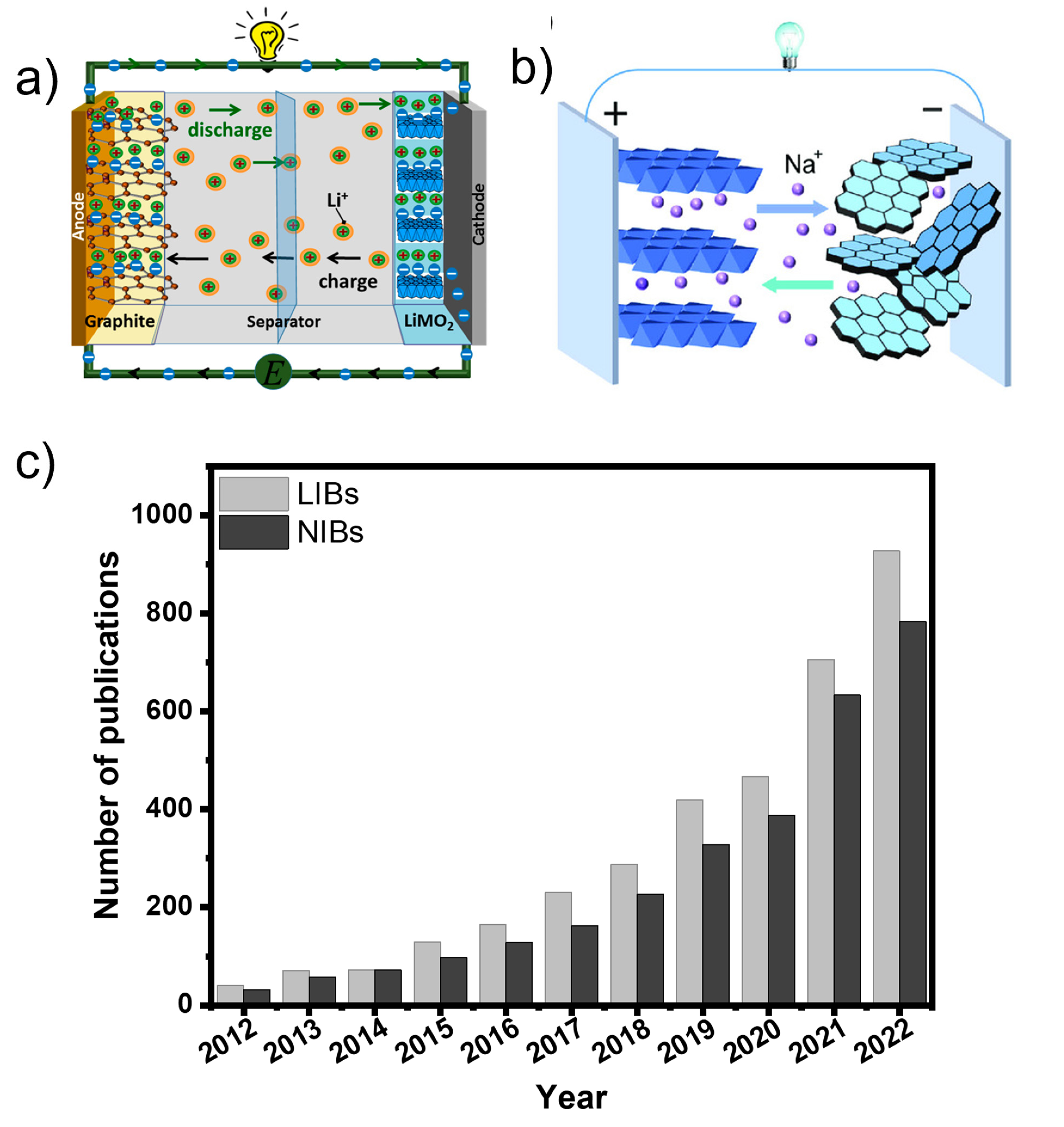
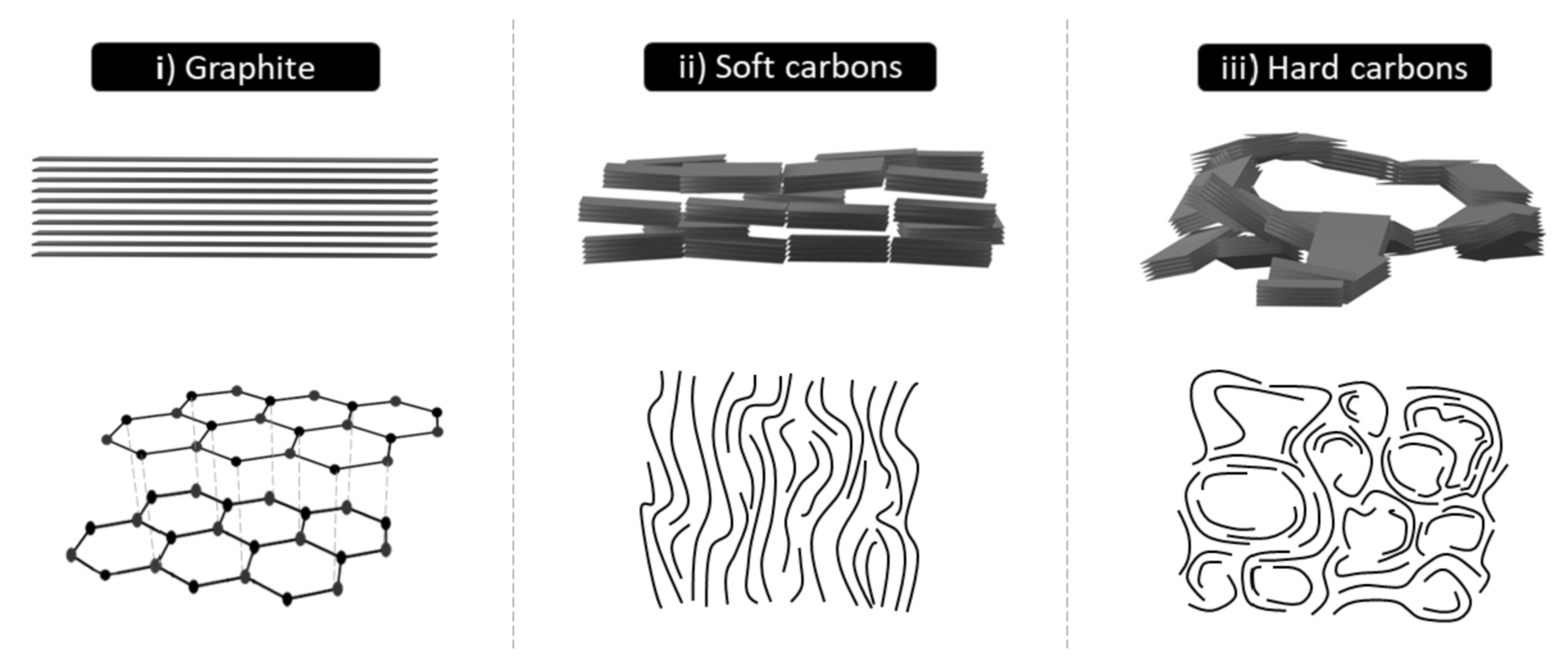
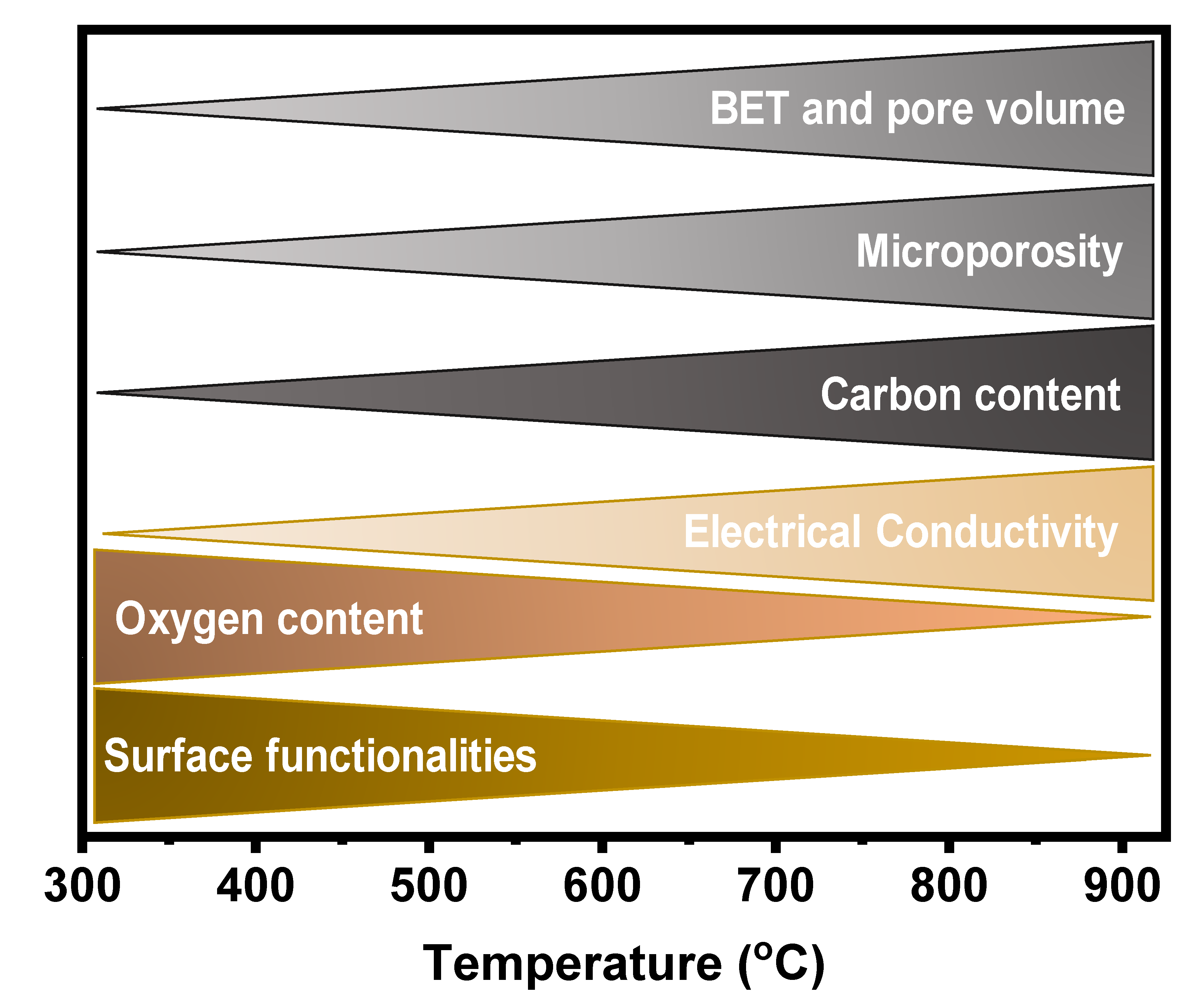
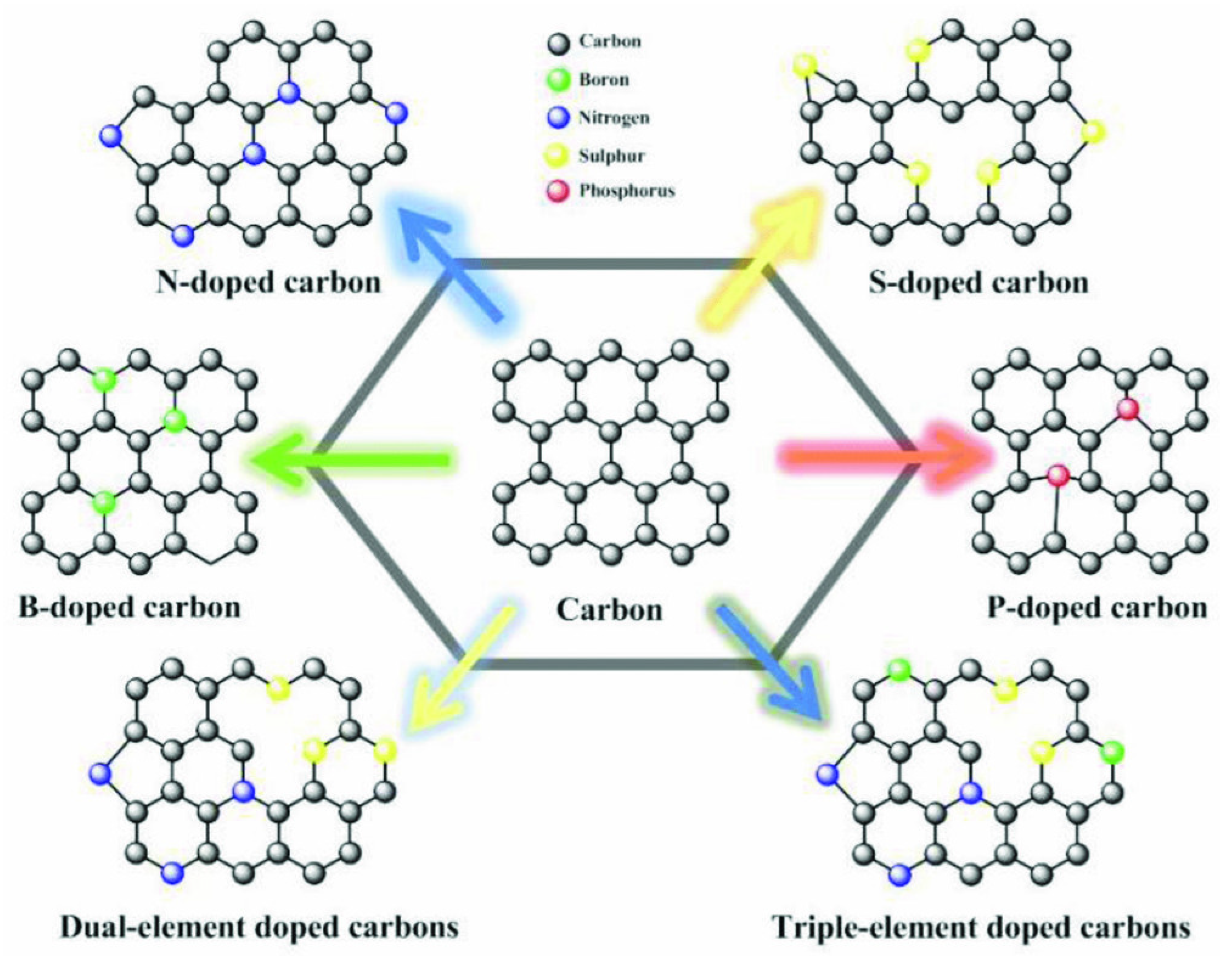

| Biomass Source | Synthesis Method | Morphology | Specific Surface Area (SSA, m2/g) | Initial Capacity (Discharge/CHARGE) (mA h g−1) | Capacity Retention (mA h g−1)/(Cycles)/Current Rate (mA g−1) | Rate Test (mA g−1), (Cycle)/Capacity (mA h g−1) | Ref. |
|---|---|---|---|---|---|---|---|
| bagasse-derived hard carbon | facile high temperature thermal decomposition method | sheet structure (HC 1000) | 92.3 | 242.1/331.3 | ~100 (1000)/1000 | 25 (5)~331 | [10] |
| camphor wood residues | carbonization followed by pyrolysis method | porous morphology | 3.74 | ~324.6/391.8 | 268.1 (200)/20 | 20 (50)~319 | [94] |
| Tea tomenta | High temperature treatment method | rod like morphology | 13.92 | ~326.1 | ~262.4 (100)/28 | - | [95] |
| cucumber stem | carbonization followed by KOH activation method | - | 1988.90 | ~1200/458.6 | 198.6 (500)/50 | - | [96] |
| chickpea husk | sonochemical activation method, | honeycomb-like morphology | 1599 | ~800/330 | ~125 (500)/20 | 1000 (500) 125 | [97] |
| seaweed-derived carbon | High porous carbon by high temperature KOH activation method | sheet like carbon structure | 1641 | 1342/287 | 192 (500)/100 | 800 (10) 114 | [98] |
| Cotton roll | carbonization followed by pyrolysis method | braided fibrous morphology and hollow structure | 38 | ~315 | ~262.4 (100)/30 | - | [99] |
| drug residue | Heat treatment method | porous structure | 989.7 | ~801/- | 402 (500)/100 | - | [100] |
Disclaimer/Publisher’s Note: The statements, opinions and data contained in all publications are solely those of the individual author(s) and contributor(s) and not of MDPI and/or the editor(s). MDPI and/or the editor(s) disclaim responsibility for any injury to people or property resulting from any ideas, methods, instructions or products referred to in the content. |
© 2023 by the authors. Licensee MDPI, Basel, Switzerland. This article is an open access article distributed under the terms and conditions of the Creative Commons Attribution (CC BY) license (https://creativecommons.org/licenses/by/4.0/).
Share and Cite
Molaiyan, P.; Dos Reis, G.S.; Karuppiah, D.; Subramaniyam, C.M.; García-Alvarado, F.; Lassi, U. Recent Progress in Biomass-Derived Carbon Materials for Li-Ion and Na-Ion Batteries—A Review. Batteries 2023, 9, 116. https://doi.org/10.3390/batteries9020116
Molaiyan P, Dos Reis GS, Karuppiah D, Subramaniyam CM, García-Alvarado F, Lassi U. Recent Progress in Biomass-Derived Carbon Materials for Li-Ion and Na-Ion Batteries—A Review. Batteries. 2023; 9(2):116. https://doi.org/10.3390/batteries9020116
Chicago/Turabian StyleMolaiyan, Palanivel, Glaydson Simões Dos Reis, Diwakar Karuppiah, Chandrasekar M. Subramaniyam, Flaviano García-Alvarado, and Ulla Lassi. 2023. "Recent Progress in Biomass-Derived Carbon Materials for Li-Ion and Na-Ion Batteries—A Review" Batteries 9, no. 2: 116. https://doi.org/10.3390/batteries9020116
APA StyleMolaiyan, P., Dos Reis, G. S., Karuppiah, D., Subramaniyam, C. M., García-Alvarado, F., & Lassi, U. (2023). Recent Progress in Biomass-Derived Carbon Materials for Li-Ion and Na-Ion Batteries—A Review. Batteries, 9(2), 116. https://doi.org/10.3390/batteries9020116











